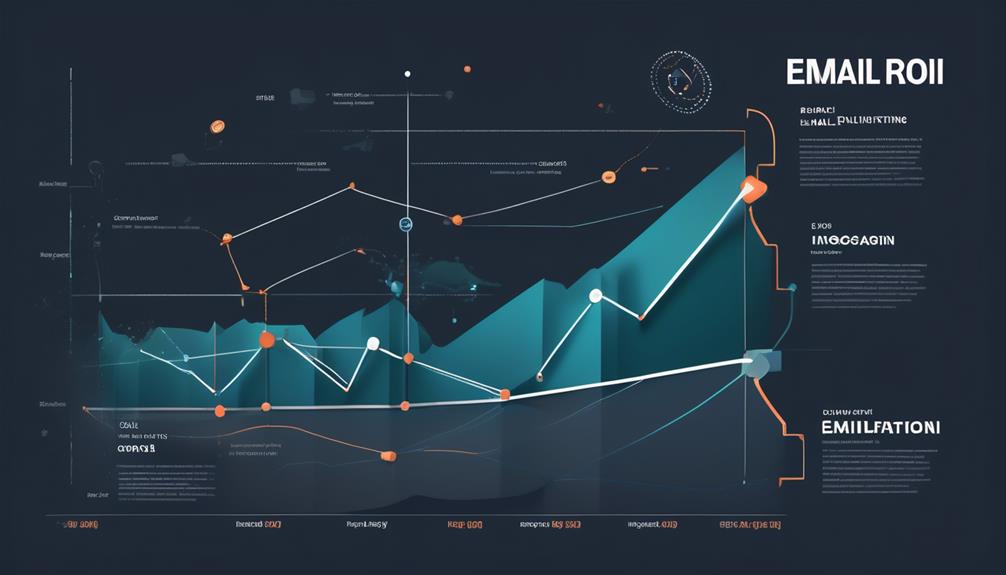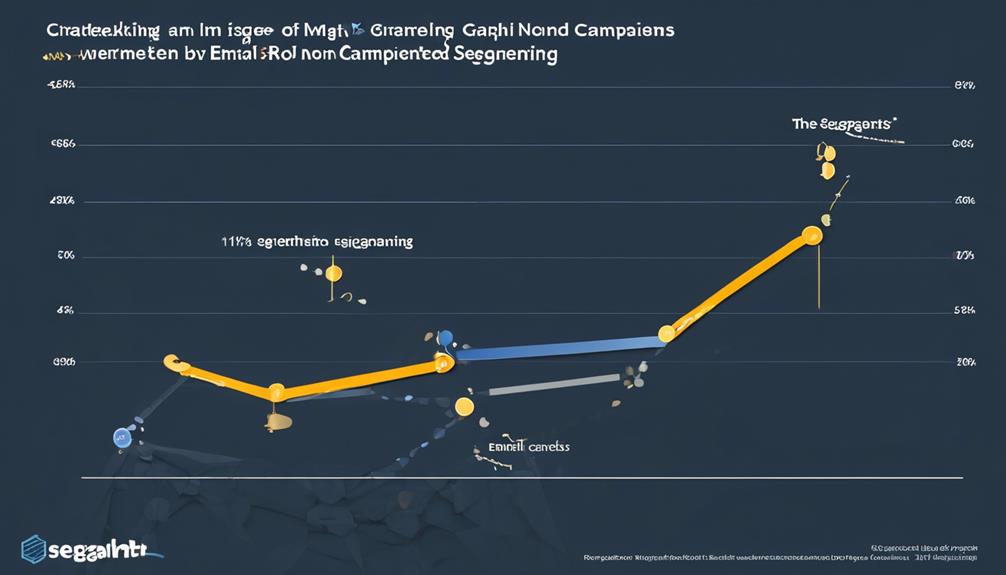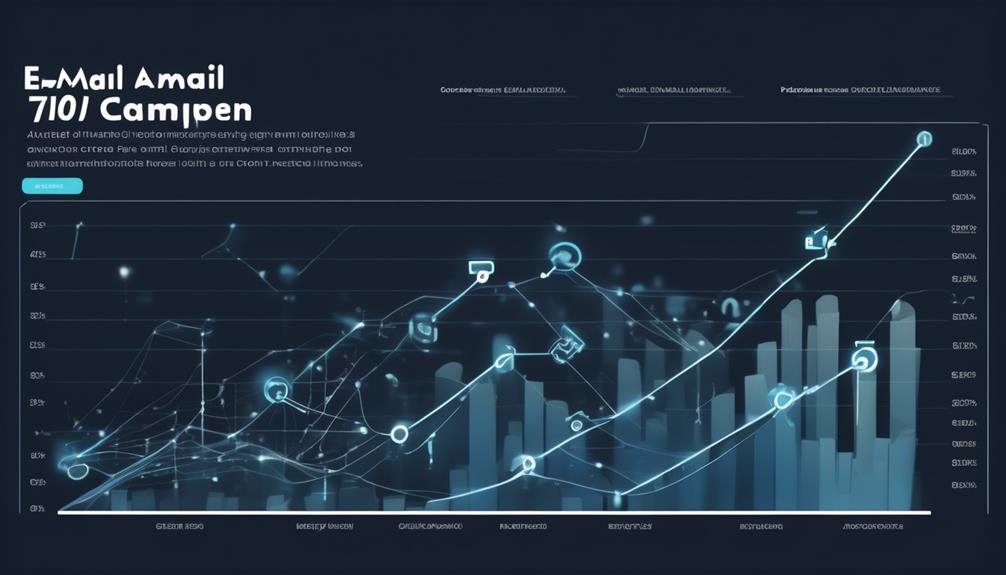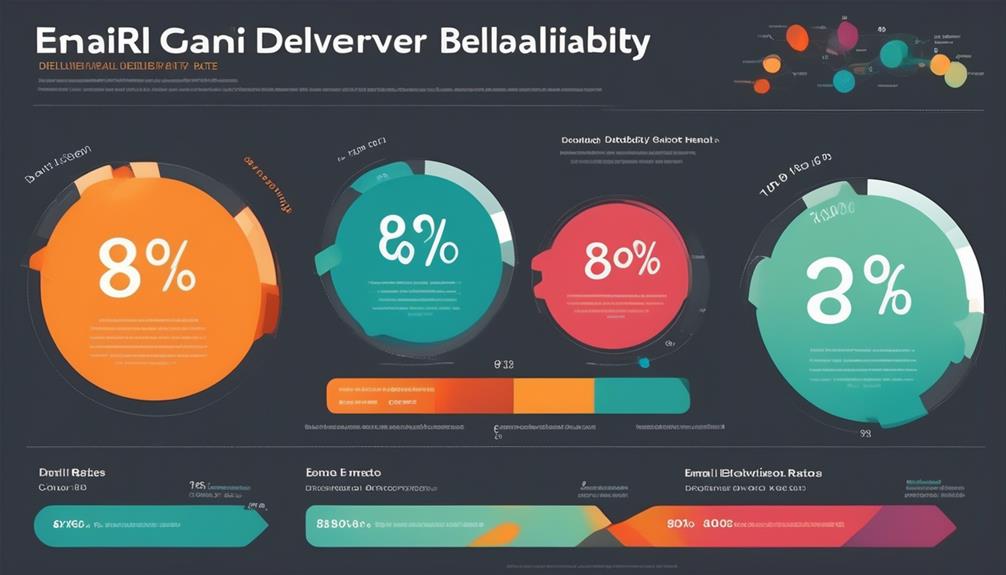Regarding the return on investment (ROI) in email marketing, it’s akin to unraveling an onion’s layers – there are numerous elements involved that influence its effectiveness.
From the effectiveness of your campaigns to industry-specific benchmarks, understanding what drives your ROI can be a complex yet crucial endeavor.
But fear not, as we explore the intricacies of these determinants, you'll gain valuable insights that can elevate your email marketing game and, ultimately, your bottom line.
Key Takeaways
- Email marketing ROI is a measure of the return on investment generated from email marketing campaigns.
- Targeted and segmented emails drive a significant portion of email marketing ROI.
- Key metrics for analyzing email marketing ROI include open rates, click-through rates, and conversion rates.
- Factors that influence email marketing ROI include subject lines, understanding the target audience, and the overall strategy and design of email campaigns.
Email Marketing ROI: Definition and Importance
Email marketing ROI represents the measure of the return on investment generated from email marketing campaigns, serving as a crucial indicator of its effectiveness and impact. With an average email ROI of $36 for every $1 spent, email marketing proves to be a highly lucrative channel.
However, it's important to note that industry-specific email marketing ROI can vary significantly, with some sectors achieving an impressive 40:1 to 53:1 ratio, highlighting the potential for substantial returns.
Calculating ROI is essential in understanding the value that email marketing generates, especially considering that 66% of consumers have made a purchase online due to an email marketing message. This underscores the significant impact that well-crafted email campaigns can have on driving sales and revenue.
Additionally, the effectiveness of targeted and segmented emails in driving 36% of email marketing ROI emphasizes the importance of strategic and personalized approaches in email marketing.
As companies continue to allocate a significant portion of their budgets to digital marketing, understanding and optimizing email marketing ROI becomes increasingly crucial for overall business success.
Key Metrics for Email Marketing ROI

When analyzing email marketing ROI, it's essential to focus on key metrics such as open rates, click-through rates, and conversion rates. These metrics provide valuable insights into the effectiveness of email campaigns and can help optimize strategies for better results.
Open Rates
With the continuous evolution of email marketing strategies, understanding and optimizing open rates has become a critical determinant of overall campaign success. Tracking email open rates is essential for measuring the effectiveness of subject lines and email content.
A higher open rate indicates better engagement and potential for conversions, making it crucial for determining the initial impact of your email marketing efforts. By monitoring open rates, we can optimize email content and subject lines, leading to improved results in email campaigns.
This data-driven approach helps us strategically enhance the ROI of our email marketing initiatives by maximizing the engagement and responsiveness of our email lists and subscribers.
Click-Through Rates
To gauge the effectiveness of our email marketing campaigns, the click-through rates serve as key metrics for analyzing audience engagement and optimizing content for improved ROI.
Click-through rates measure the percentage of recipients who click on links within the emails, providing valuable insights into the level of engagement with our content.
By monitoring and analyzing these rates, we can evaluate the effectiveness of our email campaigns and make data-driven decisions to optimize them for better results.
A high click-through rate indicates that our audience finds the content engaging, potentially leading to conversions and improved ROI.
Utilizing a marketing automation platform can help in calculating and measuring ROI, as well as testing different strategies to refine our email marketing approach for better click-through rates and overall return on investment.
Conversion Rates
Monitoring and optimizing conversion rates is essential for maximizing the effectiveness of email marketing campaigns and achieving a higher return on investment. When it comes to boosting your ROI for email marketing, focusing on conversion rates is crucial. Here are some key factors to consider:
- Analyzing and refining various elements of email marketing, such as content, design, and call-to-action buttons.
- The ability to segment email lists and personalize messages for better targeting.
- A/B testing different strategies and approaches to identify the most effective tactics.
- Monitoring the impact of email open rates and how they correlate with conversion rates.
Calculating Email Marketing ROI

When it comes to calculating email marketing ROI, we need to focus on key metrics such as revenue generated, conversion rates, and customer acquisition costs.
Understanding the factors that influence ROI, such as industry benchmarks and consumer behavior, is essential for accurate measurement.
Additionally, we should explore strategies for improving email marketing ROI, including segmentation, personalization, and automation to drive better results.
Metrics for Calculating ROI
Measuring the return on investment (ROI) for email marketing campaigns relies on key metrics to gauge performance and effectiveness. When calculating email marketing ROI, it's crucial to consider the following metrics:
- Open Rate: This metric measures the percentage of recipients who opened the email, indicating the effectiveness of the subject line and sender name.
- Click-Through Rate (CTR): CTR gauges the percentage of recipients who clicked on a link within the email, showcasing the engagement and relevance of the content.
- Conversion Rate: This metric reflects the percentage of recipients who completed a desired action, such as making a purchase, after clicking through the email.
- Bounce Rate: Bounce rate indicates the percentage of emails that weren't delivered successfully, highlighting potential issues with the email list or content.
Factors Influencing ROI
With an average ROI of $36 for every $1 spent on email marketing, understanding the factors that influence this return is essential for maximizing the effectiveness of campaigns. When it comes to email marketing ROI, several key factors play a crucial role. Here's a breakdown of the most influential factors that can impact your email marketing ROI:
| Factors | Description |
|---|---|
| Subject Lines | Compelling and personalized subject lines can significantly impact email open rates and ROI. |
| Email Users | Understanding your target audience and their behavior is essential for effective campaigns. |
| Targeted Email | Sending targeted and personalized emails to specific segments can drive higher engagement. |
| Email Addresses | Maintaining a clean and updated email list is crucial for reaching the right audience. |
| Campaigns | The overall strategy, content, and design of your email campaigns can greatly impact ROI. |
Improving Email ROI
To accurately gauge the success of email marketing efforts, calculating the return on investment (ROI) is essential for businesses seeking to optimize their strategies and allocate resources effectively. When businesses aim to improve their marketing ROI, they should consider the following strategies:
- Utilize a robust marketing platform to track and analyze campaign performance.
- Implement direct marketing techniques to reach specific audience segments effectively.
- Focus on lead nurturing to guide potential customers through the sales funnel.
- Craft personalized emails to enhance engagement and conversion rates.
Factors Affecting Email Marketing ROI

The effectiveness of an email marketing campaign and the quality of the email list are key factors that can significantly impact the ROI. An email campaign's success is heavily dependent on the quality of the content, the relevance of the message, and the ability to engage the audience. Additionally, the email list quality plays a crucial role in determining the ROI. A targeted and well-nurtured email list can yield higher conversion rates, thus positively impacting the ROI.
When evaluating the factors affecting email marketing ROI, it's essential to consider the email marketing strategy, the use of an ROI calculator, and the optimization of email subjects. The strategic alignment of the email marketing efforts with the overall marketing strategies and business objectives is pivotal. Furthermore, setting clear and measurable goals for the email marketing campaign is imperative for accurately assessing the ROI.
In essence, understanding the various factors influencing email marketing ROI, such as the email campaign's effectiveness, the quality of the email list, and the alignment with business objectives, is critical for devising a successful email marketing strategy and maximizing ROI.
Strategies to Improve Email Marketing ROI

Understanding the key factors that influence email marketing ROI, we can now explore strategic approaches to enhance campaign performance and maximize returns.
- Build robust and clean email lists to reach a wider audience.
- Capture more information about each customer to create personalized messages.
- Find out what customers want from email campaigns and target promotions accordingly.
- Avoid sending generic emails and offer unique deals to make customers feel special.
Personalization and Email Marketing ROI

By harnessing the power of personalized emails, businesses can significantly enhance their email marketing ROI. Personalization allows for highly targeted and relevant content, leading to emails that convert and ultimately drive revenue. According to the facts, personalized emails can result in a 6x higher transaction rate and an 18x increase in revenue compared to non-personalized ones. This emphasizes the direct impact of personalization on email marketing ROI. Additionally, utilizing customer data for personalization can lead to a 50% higher click-through rate and a 77% increase in email marketing ROI, further highlighting the strategic importance of personalized content. Furthermore, segmented and personalized emails have shown a staggering 760% increase in revenue, indicating the immense potential for ROI growth through effective personalization strategies. By creating highly personalized and relevant content based on customer data, businesses can not only drive revenue but also increase brand awareness and create successful email marketing campaigns.
| Personalization and Email Marketing ROI | ||
|---|---|---|
| Key Benefits | Impact on ROI | Strategic Importance |
| 6x higher transaction rate | Higher revenue | Utilizing customer data |
| 18x more revenue | Increased click-through | Highly targeted content |
| 760% increase in revenue | Enhanced brand awareness | Relevant and successful emails |
Segmentation's Impact on Email Marketing ROI

Utilizing effective segmentation strategies in email marketing can significantly impact ROI by allowing for targeted and personalized messaging to specific customer segments. The impact of segmentation on email marketing ROI is substantial, with a 36% increase attributed to the implementation of segmented and personalized emails. Moreover, businesses can experience a remarkable 760% boost in revenue when employing segmented and personalized emails, emphasizing the profound influence of segmentation on ROI.
Additionally, effective segmentation and personalization strategies contribute to higher email engagement and conversion rates, directly impacting email marketing ROI. By tailoring email content to specific customer segments, businesses can enhance relevancy, thereby driving higher ROI.
Furthermore, segmentation enables businesses to target different customer segments with tailored content, leading to increased customer retention and loyalty, which positively impacts email marketing ROI.
Automation and Email Marketing ROI

Segmentation's impact on email marketing ROI underscores the significance of targeted and personalized messaging. Now, diving into the realm of automation, its potential to revolutionize email campaigns and elevate ROI becomes evident.
Automation plays a pivotal role in enhancing email marketing efforts and maximizing ROI. By leveraging automation tools, businesses can create personalized and targeted email newsletters, leading to higher engagement and conversion rates, which are critical components of the ROI formula.
Additionally, automation enables the tracking and analysis of email performance, providing valuable insights for optimizing future campaigns and improving ROI. Automated workflows contribute to lead nurturing, nurturing potential customers through the sales funnel and ultimately impacting ROI positively.
Furthermore, automation allows for the delivery of timely and relevant content to subscribers, increasing engagement and driving website traffic, which can directly influence ROI. Streamlining processes, saving time, and improving efficiency are additional benefits of implementing automation in email marketing, ultimately contributing to a more successful email marketing strategy and higher ROI.
Email Deliverability and ROI

Email deliverability directly impacts the success of email marketing campaigns and is a key determinant of ROI. To maximize the ROI of email marketing, it's crucial to prioritize and optimize email deliverability.
Here are some key factors to consider:
- Sender Reputation: Maintaining a positive sender reputation is essential for achieving high email deliverability and, subsequently, a higher ROI.
- Content Quality: Creating high-quality, relevant, and engaging email content can contribute to improved email deliverability and, in turn, enhance the ROI of email marketing efforts.
- List Hygiene: Regularly cleaning and segmenting email lists to remove inactive or disengaged subscribers is vital for sustaining high email deliverability rates and maximizing ROI.
- Authentication Protocols: Implementing robust email authentication protocols such as SPF, DKIM, and DMARC can significantly enhance email deliverability, leading to a positive impact on the ROI of email marketing.
Monitoring and Adjusting Email Marketing ROI

We must consistently monitor email open rates and click-through rates to gauge engagement and make necessary adjustments to our campaigns.
By tracking website traffic generated from email marketing, we can optimize content and design to enhance user experience and drive more conversions.
Additionally, implementing audience segmentation strategies will allow us to tailor email content and improve overall campaign performance.
Tracking Campaign Performance
Continuously monitoring and adjusting email campaign performance is essential for maximizing our email marketing ROI. To achieve this, we rely on various tools and strategies to track our email marketing effectiveness. Here's how we do it:
- Utilize Google Analytics: We leverage this powerful tool to gain insights into how our email campaigns drive traffic to our website and influence user behavior.
- Analyze engagement metrics: We regularly assess open rates, click-through rates, and conversion rates to gauge the effectiveness of our email campaigns.
- Measure email-generated sales: We closely monitor and analyze the purchases resulting from our email campaigns to understand their impact on our revenue.
- Compare with other marketing channels: We assess our email marketing ROI against other digital marketing and sales methods, enabling strategic adjustments for maximum impact.
Optimizing Content and Design
Monitoring and adjusting content and design regularly is crucial for maximizing engagement and conversions in email marketing. By employing A/B testing, we can experiment with different content and design elements to identify what resonates best with our audience. Keeping a close watch on email open rates, click-through rates, and conversion rates allows us to gauge the effectiveness of our content and design. Analyzing customer behavior and preferences enables us to tailor content and design for better ROI. Leveraging marketing automation to personalize content and design ensures it aligns with customer interests and needs. To further illustrate the importance of optimizing content and design, consider the following table:
| Metric | Goal |
|---|---|
| Email Open Rate | Increase by 15% |
| Click-Through Rate | Achieve 10% or higher |
| Conversion Rate | Reach 5% |
| Personalization | Implement dynamic content for 20% of subscribers |
This data-driven approach will ultimately lead to more successful email marketing campaigns and higher ROI.
Audience Segmentation Strategies
Using data-driven audience segmentation strategies is key to optimizing and adjusting email marketing ROI. When implementing audience segmentation strategies, consider the following:
- Segment your email list based on demographics, behavior, and preferences to deliver personalized content that resonates with each recipient.
- Use past purchase history and browsing behavior to tailor product recommendations and promotions, increasing the likelihood of conversions.
- Implement dynamic content to ensure that each subscriber receives the most relevant and engaging content, leading to higher open and click-through rates.
- Leverage automation to deliver timely and targeted messages, nurturing leads and retaining customers throughout their journey with your brand.
Frequently Asked Questions
What Is a Good ROI for Email Marketing?
A good ROI for email marketing varies across industries, with some sectors seeing a return as high as 53:1. It's a crucial metric for ecommerce companies, as 66% of consumers make purchases due to email marketing.
Our data-driven approach ensures we optimize our email campaigns to achieve a solid ROI. We constantly analyze and refine our strategies to ensure we're maximizing the potential of our email marketing efforts.
How Do You Calculate ROI for Email Marketing?
We calculate email marketing ROI by estimating profits and costs using the formula (Gained – Spent) / Spent = ROI.
It's crucial to consider industry benchmarks for a good ROI.
Monitoring metrics such as engagement, website traffic, email-generated sales, conversion rates, and revenue impact is essential.
To improve ROI, we set SMART goals, use top email automation platforms, design attractive emails, focus on segmentation and personalization, ensure email deliverability, and build a mobile-friendly user experience.
What Leads to Better Returns Email Marketing Roi?
Targeted and segmented emails, personalized messaging, and robust email lists contribute significantly to better returns on email marketing ROI. These strategies impact consumer behavior, leading to increased engagement, website traffic, and sales.
Monitoring metrics such as open rates, click-through rates, and conversion rates is vital for campaign success. Implementing effective tactics and strategies, such as avoiding generic emails, is crucial for improving email marketing ROI.
Has an Average ROI of $38 for Every $1 Spent on Email Marketing?
We've got some exciting news! The average ROI for email marketing is actually $36 for every $1 spent. This makes it one of the most cost-effective marketing strategies out there.
It's crucial to remember that ROI can vary across industries. For instance, software and technology boast a 40:1 ratio, while travel, tourism, and hospitality lead the pack at 53:1. These numbers emphasize the potential for high returns with targeted email campaigns.
How Can I Measure the ROI of my Email Marketing Efforts?
Measuring the success of your email marketing campaigns can be done using various email marketing ROI measurement strategies. These may include tracking click-through rates, conversion rates, and overall revenue generated from email campaigns. Utilizing the right metrics and analysis tools can provide valuable insights into the effectiveness of your email marketing efforts.
Conclusion
In conclusion, understanding the factors that determine email marketing ROI is crucial for optimizing campaign performance.
Did you know that personalized emails deliver 6x higher transaction rates?
By focusing on key metrics, industry trends, and continuous optimization, we can drive better results and maximize our return on investment.
Let's leverage data and strategic insights to enhance our email marketing efforts and achieve higher ROI.










